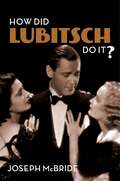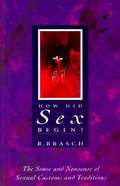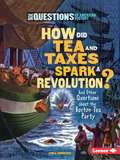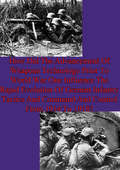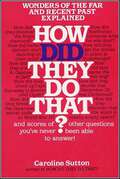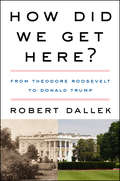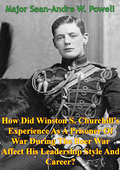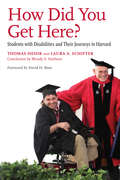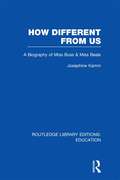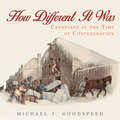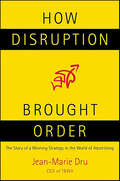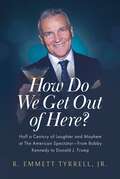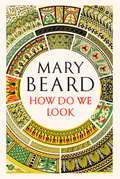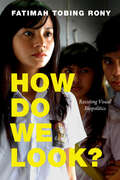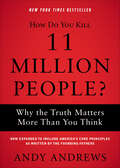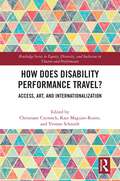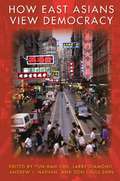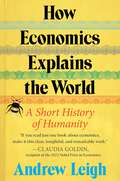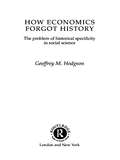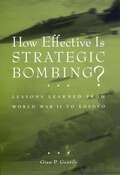- Table View
- List View
How Did Lubitsch Do It?
by Joseph McBrideOrson Welles called Ernst Lubitsch (1892–1947) “a giant” whose “talent and originality are stupefying.” Jean Renoir said, “He invented the modern Hollywood.” Celebrated for his distinct style and credited with inventing the classic genre of the Hollywood romantic comedy and helping to create the musical, Lubitsch won the admiration of his fellow directors, including Alfred Hitchcock and Billy Wilder, whose office featured a sign on the wall asking, “How would Lubitsch do it?” Despite the high esteem in which Lubitsch is held, as well as his unique status as a leading filmmaker in both Germany and the United States, today he seldom receives the critical attention accorded other major directors of his era.How Did Lubitsch Do It? restores Lubitsch to his former stature in the world of cinema. Joseph McBride analyzes Lubitsch’s films in rich detail in the first in-depth critical study to consider the full scope of his work and its evolution in both his native and adopted lands. McBride explains the “Lubitsch Touch” and shows how the director challenged American attitudes toward romance and sex. Expressed obliquely, through sly innuendo, Lubitsch’s risqué, sophisticated, continental humor engaged the viewer’s intelligence while circumventing the strictures of censorship in such masterworks as The Marriage Circle, Trouble in Paradise, Design for Living, Ninotchka, The Shop Around the Corner, and To Be or Not to Be. McBride’s analysis of these films brings to life Lubitsch’s wit and inventiveness and offers revealing insights into his working methods.
How Did Sex Begin?
by R. BraschWitty, candid investigation of the myths, traditions and practices surrounding this most popular of human pursuits, originally published in Australia in 1973. The author has written 30 books including 'How did Sport Begin?' and 'There's a Reason for Everything'. He is a scholar in the fields of theology, philosophy and history and was awarded the Media Peace prize in 1979.
How Did Sports Begin: A Look at the Origins of Man at Play
by R. BraschWhat sport was once credited with halting the declining British marriage rate? How did "love" find its way into tennis scoring, or the bull's-eye into archery? How did badminton get its name? What is the only sport invented in America? Sports are as old as time, and the story of where and how they were first played and how they evolved into present-day form is entertaining reading, full of surprises. From cricket and croquet to water skiing and wrestling, forty-five different sports are given their genesis here. Some had mysterious beginnings: the fatherhood of baseball was in dispute for years. Some are older than we would imagine: skis are thought to be more than 5,000 years old, and football dates from 2nd-century China. Others came into existence by accident: a headache led to the discovery of the modern-day Ping-Pong bat! Whatever your interest-and which of us hasn't succumbed to the lure of "the game," either personally or vicariously?-Dr. Brasch's learned eye will turn up fascinating data to satisfy the curiosity of spectators and participants alike. Dr. R. Brasch, chief minister of Temple Emanuel in Sydney, is a student of twelve languages. He is also a broadcaster, telecaster, and contributor to numerous international magazines and journals, and has lectured at universities in America, England, Ireland, South Africa, and Australia. Among his previous books are The Judaic Heritage; Mexico-A Country of Contrasts; and How Did It Begin?, which explores the origins of customs, superstitions, and habits that influence our lives today.
How Did Tea And Taxes Spark A Revolution?: And Other Questions About The Boston Tea Party (Six Questions Of American History)
by Linda GondoschOn a cold evening in December 1773, a group of men climbed aboard three ships docked in Boston Harbor. Armed with hatchets, the men began breaking into the ships’ valuable cargo―342 crates of tea. They dumped the tea into the black water of the harbor and then marched back home through the city streets. This “Boston Tea Party” was a bold act of protest by American colonists against British rule. It pushed the colonies and Great Britain a step closer to war. But who were these protestors? Why would they risk angering the powerful British government? And how did the British respond? Discover the facts about the Boston Tea Party and the colonists’ struggle for independent rule.
How Did The Advancement Of Weapons Technology Prior To World War One: Influence The Rapid Evolution Of German Infantry Tactics And Command And Control From 1914 To 1918?
by Major Daniel T. LathropThe fact that there has been significant evolution in infantry tactics during the past century is taken for granted. Also, it is well documented that the predominant advancements in tactics took place between 1914 and 1918, during World War One, rooted within the German army. However, the cause and effect that initiated this rapid evolution is somewhat unclear. Was this advancement solely due to the inspiration of one or more German commanders of the time? Was this advancement in tactics a Revolution in Military Affairs? Or, was this merely an evolution in tactics resulting from advancements in fire power due to technology improvements in infantry weapons such as the machine gun, infantry rifle, field artillery, etc.Prior to World War I the German army had studied and toyed with new tactics off and on. By 1914 they were still practicing traditional tactics against the Allies. The use of these tactics against the massive destructive capability of modern weapons available to both sides at the start of the war caused enormous numbers of casualties. The German army, in comparison to the Allies, was limited in numbers of soldiers and material and could not afford to continue to keep up with the high attrition rate. Necessity being the mother of invention, the Germans acted aggressively in finding a way to defeat the advanced firepower that emerged during the war. Through experimentation and training they developed the famous "Storm Troops" that momentarily broke the deadlock near the end of the war. After World War I these new tactics were taken up by other forces around the world and eventually led to German Blitzkrieg tactics of World War Two.
How Did They Do That?
by Caroline SuttonThe totally satisfying answers to more than 100 questions that drive normal people—not to mention infomaniacs and trivia buffs—crazy.Questions about matters great and small, from ancient times to yesterday.Illustrated with illuminating technical drawings and unusual vintage photographs.How did they spend $40 million making Heaven's Gate?How did they decide the length of a mile?How did Beethoven compose when he was deaf?How did they discover the Hope diamond?How did they know the size of the Earth over 1,700 years before anyone sailed around it?How did they set the price of the Louisiana Purchase?How did the FBI devise the "Ten Most Wanted" list?How did they decide which horses were Thoroughbreds?How did they pick the Four Hundred?How did they start the Guiness Book of World Records?How did the Indians decide that cows were sacred?How did they discover penicillin?How did they build the Great Pyramid at Giza?How did they decide how tall to make the Empire State Building?How did they know there was an El Dorado?How did they start the Chicago fire of 1871?How did Hannibal cross the Alps?
How Did We Get Here?: From Theodore Roosevelt to Donald Trump
by Robert DallekThe award-winning, New York Times bestselling historian considers the vast array of triumphs and failures of America’s modern presidents that paved a path to Donald Trump, offering an understanding of our current moment and hope for a way back to true leadership.The struggle to preserve the Republic has never been easy or without perils. The rise of conflicting political parties, which the founders opposed, and President John Adams’ Alien and Sedition Acts repressing First Amendment rights made Franklin’s observation at the conclusion of the Constitutional Convention—“a republic, if you can keep it”—seem prescient.In the twentieth century, America endured numerous struggles: economic depression, World War II, McCarthyism, the Vietnam War, Watergate, the Iran-contra scandal, the war in Iraq—all of which gave rise to demagogues, as did the growth and reach of mass media. But this wasn’t the Founding Fathers’ vision for our leadership. The resistance to putting a demagogue in the White House survived the anti-Communist agitation of the 1950s and the Vietnam War in the 1960s. But the latter opened the way for Richard Nixon’s election in 1968 and Watergate, which again tested our democratic institutions and the rule of law. Nixon’s resignation in August 1974 moved Vice President Gerald Ford, his successor, to declare, “My fellow Americans, our long national nightmare is over.”But was it? Donald Trump’s 2016 election has presented a new challenge. How did past politics and presidential administrations pave the way for this current assault on American democracy? Our nation’s history provides reassurance that we will restore our better angels to government. Yet it must be considered that earlier administrations and public outlook facilitated the rise of such an un-presidential character as Trump in the first place. In How Did We Get Here?, Robert Dallek considers a century of modern administrations, from Teddy Roosevelt to today, shining a light on the personalities behind the politics and the voters who elected each. His cautionary tale reminds us that the only constant in history is change, but whether for good or ill the choice is Americans’ to make.
How Did Winston S. Churchill’s Experience As A Prisoner Of War: During The Boer War Affect His Leadership Style And Career?
by Major Sean-Andre W. PowellThis thesis will examine how Churchill's experience in the Boer War affected his career and leadership style. Initial research revealed that Churchill planned to make some major life decisions in 1899 the year he participated in The Boer War. Fate and other variables such as his financial independence and celebrity status enabled rapid realization of his goals to attain political office in the British government. Research indicated that Churchill's experience while a Boer prisoner of war (POW) and his subsequent escape proved to be an especially formative experience for him professionally. In addition, his POW experience taught him the Boer perspective of the conflict, which developed his leadership and personality. Secondary questions answered are: How did his experience as a POW affect him? What did his experiences in Cuba, India, and Sudan teach him? What were Churchill's motivations during his time in the British Army? Using a chronological approach throughout this paper will provide the reader with the most logical and easiest method of answering these questions.
How Did You Get Here?: Students with Disabilities and Their Journeys to Harvard
by David Rose Thomas Hehir Wendy S. Harbour Laura A. SchifterWhen their children were young, several parents interviewed in this book were told "you can't expect much from your child." As they got older, the kids themselves often heard the same thing: that as children with disabilities, academic success would be elusive, if not impossible, for them. How Did You Get Here? clearly refutes these common, destructive assumptions. It chronicles the educational experiences--from early childhood through college--of sixteen students with disabilities and their paths to personal and academic success at Harvard University. The book explores common themes in their lives--including educational strategies, technologies, and undaunted intellectual ambitions--as well as the crucial roles played by parents, teachers, and other professionals. Above all, it provides a clear and candid account--in the voices of the students themselves--of what it takes to grapple effectively with the many challenges facing young people with disabilities. A compelling and practical book, How Did You Get Here?offers clear accounts not only of the challenges and biases facing young disabled students, but also of the opportunities they found, and created, on the way to academic and personal success.
How Did You Get Here?: Students with Disabilities and Their Journeys to Harvard
by Thomas Hehir Wendy S. Harbour Laura A. SchifterWhen their children were young, several parents interviewed in this book were told &“you can&’t expect much from your child.&” As they got older, the kids themselves often heard the same thing: that as children with disabilities, academic success would be elusive, if not impossible, for them. How Did You Get Here? clearly refutes these common, destructive assumptions. It chronicles the educational experiences—from early childhood through college—of sixteen students with disabilities and their paths to personal and academic success at Harvard University. The book explores common themes in their lives—including educational strategies, technologies, and undaunted intellectual ambitions—as well as the crucial roles played by parents, teachers, and other professionals. Above all, it provides a clear and candid account—in the voices of the students themselves—of what it takes to grapple effectively with the many challenges facing young people with disabilities. A compelling and practical book, How Did You Get Here?offers clear accounts not only of the challenges and biases facing young disabled students, but also of the opportunities they found, and created, on the way to academic and personal success.
How Different From Us: A Biography of Miss Buss and Miss Beale (Routledge Library Editions: Education)
by Josephine KammFrances Mary Buss, who began her teaching career at fourteen, was only twenty-three when she founded the North London Collegiate School, the forerunner and model of Girls’ High Schools throughout the country. Her friend Dorothea Beale was for nearly fifty years Principal of Cheltenham Ladies College, which she changed from an insignificant local school into a school and college with a comprehensive teacher training department and with upwards of a thousand pupils. She was also the founder of St.Hilda’s College, Oxford. Imbued with strong religious principles and endowed with immense energy and industry, the two women exercised a powerful influence on the development of women’s education in Britain. Yet both had to contend with bitter opposition and disillusionment. This is the first joint biography of Miss Buss and Miss Beale and it gives a fascinating comparison of their methods and widely differing characters. The author had access to hitherto unpublished material, and gathered information from pupils of both schools and from others who knew the two headmistresses, ensuring that the book, whilst full of anecdotes, is also authoritative.
How Different It Was: Canadians at the Time of Confederation
by Michael J. GoodspeedAn enthralling exploration of the lifestyles, ideas, habits, organizations, customs, fears, and aspirations of Canadians in the age of Confederation. Too often we think of Victorian Canada as dull. We imagine our ancestors as sepia-tinged, dour, excruciatingly respectable figures sitting stiffly in over-decorated parlours. In How Different It Was, Michael J. Goodspeed changes all that, bringing to life the tumult and enthusiasm of ordinary and unconventional Canadians — from across the country and every walk of life — in an extraordinary time. The political manoeuvring and power struggles of the decades when Canada was emerging as a nation are well known, but we are less familiar with the lives and circumstances of everyday Canadians in the Confederation era. How Different It Was vividly brings to life the lifestyles, attitudes, habits, and mindset of a colourful generation of Canadians who were, in so many ways, so different from our own.
How Disruption Brought Order: The Story of a Winning Strategy in the World of Advertising
by Jean-Marie Dru“Quite simply and without a shadow of a doubt the best book about advertising ever written . . . a treasure trove of brilliant examples and anecdotes.” ―Donald Gunn, Founder, The Gunn ReportIn his previous bestselling books, global advertising icon Jean-Marie Dru explored the visionary, innovative techniques that have become a hallmark of TBWA Worldwide campaigns. Now he gives a first-hand account of how the bold methods of disruption launched TBWA to the forefront of international advertising. Here he shares personal insights and anecdotes about his life in advertising as well as lessons learned, revealing how client campaigns for Nissan, Adidas, and the Apple iPhone became such unqualified successes. Both a fascinating business memoir and a practical guide to harnessing the power of disruption, this book offers a look at the cutting edge of modern advertising.“In this honest, fast-paced, and endlessly useful book, Jean-Marie Dru, a disruptive thinker who has helped so many great companies redefine their brands and marketing messages, explains how his one-of-a-kind company works—and how his ideas can help you rethink how your company works and wins.” ―William C. Taylor, New York Times–bestselling author“All great breakthrough business ideas have involved breaking with convention, but Dru's penchant for articulating the need for creative destruction brings decisiveness and encouragement to a field that constantly searches for ways to bring renewal to the process.” ―Booklist“From the CEO down, we live at a time when every organization should be looking at their business in a creative way. If you don't know how to do it, read this book.” ―Terry Savage, Executive Chairman, Cannes Lions International Advertising Festival
How Do We Get Out of Here?: Half a Century of Laughter and Mayhem at The American Spectator—From Bobby Kennedy to Donald J. Trump
by R. Emmett Tyrrell Jr.How Do We Get Out of Here? is R. Emmett Tyrrell, Jr.&’s intimate memoir, detailing his leadership in the conservative movement and his relationships with its major personalities from 1968 to the present.When R. Emmett Tyrrell, Jr. was a conservative college student in 1968, he watched as Senator Robert Kennedy gave a rousing campaign speech. When Senator Kennedy asked him, &“How do we get out of here?&” Tyrrell—the only other person onstage—not only escorted the candidate to his car but boldly pressed a &“Reagan for President&” button into the legendary Democrat&’s hand. This early, irreverent political prank marked Tyrrell&’s entrance into what would become a decades-long engagement at the heart of American politics as founder and publisher of the legendary conservative magazine, The American Spectator. Tyrrell has now written a candid memoir of those tumultuous years, complete with fascinating—and often, uproarious—behind-the-scenes vignettes of the turbulent politics and the most prominent political and literary personalities of the era, including the Spectator&’s furious political battles with Bill Clinton, the author&’s close association with Ronald Reagan, his warm relations and competition with William F. Buckley of the National Review, his friendship with a post-presidential Richard Nixon, and the chaotic years of Donald Trump&’s presidency. Written in Tyrrell&’s trademark unfailing and bitingly satirical style, How Do We Get Out of Here? is an invaluable and intimate recount of the political and cultural battles that shaped our contemporary politics, written by a raconteur whose fearless muckraking materially impacted the politics of the modern era.
How Do We Look: The Body, The Divine, And The Question Of Civilization
by Mary BeardFrom prehistoric Mexico to modern Istanbul, Mary Beard looks beyond the familiar canon of Western imagery to explore the history of art, religion, and humanity. Conceived as a gorgeously illustrated accompaniment to “How Do We Look” and “The Eye of Faith,” the famed Civilisations shows on PBS, renowned classicist Mary Beard has created this elegant volume on how we have looked at art. Focusing in Part I on the Olmec heads of early Mesoamerica, the colossal statues of the pharaoh Amenhotep III, and the nudes of classical Greece, Beard explores the power, hierarchy, and gender politics of the art of the ancient world, and explains how it came to define the so-called civilized world. In Part II, Beard chronicles some of the most breathtaking religious imagery ever made—whether at Angkor Wat, Ravenna, Venice, or in the art of Jewish and Islamic calligraphers— to show how all religions, ancient and modern, have faced irreconcilable problems in trying to picture the divine. With this classic volume, Beard redefines the Western-and male-centric legacies of Ernst Gombrich and Kenneth Clark.
How Do We Look?: Resisting Visual Biopolitics (a Camera Obscura book)
by Fatimah Tobing RonyIn How Do We Look? Fatimah Tobing Rony draws on transnational images of Indonesian women as a way to theorize what she calls visual biopolitics—the ways visual representation determines which lives are made to matter more than others. Rony outlines the mechanisms of visual biopolitics by examining Paul Gauguin’s 1893 portrait of Annah la Javanaise—a trafficked thirteen-year-old girl found wandering the streets of Paris—as well as US ethnographic and documentary films. In each instance, the figure of the Indonesian woman is inextricably tied to discourses of primitivism, savagery, colonialism, exoticism, and genocide. Rony also focuses on acts of resistance to visual biopolitics in film, writing, and photography. These works, such as Rachmi Diyah Larasati’s The Dance that Makes You Vanish, Vincent Monnikendam’s Mother Dao (1995), and the collaborative films of Nia Dinata, challenge the naturalized methods of seeing that justify exploitation, dehumanization, and early death of people of color. By theorizing the mechanisms of visual biopolitics, Rony elucidates both its violence and its vulnerability.
How Do You Kill 11 Million People?: Why the Truth Matters More Than You Think
by Andy AndrewsHow do you get away with the murder of 11 million people? The answer is simple—and disturbing. You lie to them. Learn how you can become an informed, passionate citizen who demands honesty and integrity from your leaders in this updated and expanded edition of the original New York Times bestselling book.In this updated and expanded nonpartisan New York Times bestselling book, Andy Andrews emphasizes that seeking and discerning the truth is of critical importance, and that believing lies is the most dangerous thing you can do. You&’ll be challenged to become a more careful student of the past, seeking accurate, factual accounts of events that illuminate choices our world faces now.By considering how the Nazi German regime was able to carry out over eleven million institutional killings between 1933 and 1945, Andrews advocates for an informed population that demands honesty and integrity from its leaders and from each other.This thought-provoking book poses questions like:What happens to a society in which truth is absent?How are we supposed to tell the difference between the &“good guys" and the &“bad guys&”?How does the answer to this question affect our country, families, faith, and values?Does it matter that millions of ordinary citizens aren't participating in the decisions that shape the future of our country? Which is more dangerous: politicians with ill intent, or the too-trusting population that allows such people to lead them?This is a wake-up call: we must become informed, passionate citizens or suffer the consequences of our own ignorance and apathy. We can no longer measure a leader&’s worth by the yardsticks provided by the left or the right. Instead, we must use an unchanging standard: the pure, unvarnished truth.
How Does Disability Performance Travel?: Access, Art, and Internationalization (Routledge Series in Equity, Diversity, and Inclusion in Theatre and Performance)
by Yvonne Schmidt Christiane Czymoch Kate Maguire-RosierThis edited collection investigates the myriad ways in which disability performance travels in a globalized world. Disability arts festivals are growing in different parts of the world; theatre and dance companies with disabled artists are increasingly touring and collaborating with international partners. At the same time, theatre spaces are often not accessible, and the necessity of mobility excludes some disabled artists from being part of an international disability arts community. How does disability performance travel, who does not travel – and why? What is the role of funding and producing structures, disability arts festivals and networks around the world? How do the logics of international (co-)producing govern the way in which disability art is represented internationally? Who is excluded from being part of a touring theatre or dance company, and how can festivals, conferences, and other agents of a growing disability culture create other forms of participation, which are not limited to physical co-presence? This study will contextualize disability aesthetics, arts, media, and culture in a global frame, yet firmly rooted in its smaller national, state, and local community settings and will be of great interest to students and scholars in the field.
How Does Olive Oil Lose its Virginity?: Answers to the Enigmatic Questions of Contemporary Life
by Mark Watson Bruce TindallThis much anticipated sequel to the authors' popular Did Mohawks Wear Mohawks? stimulates the mind as much as it tickles the funny bone with scores of concise, witty answers to the questions you never dared to ask Mom or your high school science teacher! From the ridiculous to the sublime, Tindall and Watson tackle the conundrums of the day, examining everything from the history of "booing" bad performances to the mysterious darkness that lurks in the heart of the oyster. Whether the subject is soft drinks or shrunken heads, bumper stickers or boomerangs, How Does Olive Oil Lose Its Virginity? is your road map through an increasingly wacky world. With over 50 questions on a myriad of topics, How Does Olive Oil Lose Its Virginity? provides readers with hours of entertainment and a wealth of factual knowledge. Each answer has been carefully researched and well documented and offers great background information. And of course, all the answers are peppered with the trademark wit and spunk popularized by Tindall and Watson.
How East Asians View Democracy
by Larry Diamond Doh Chull Shin Andrew J. Nathan Yun-Han ChuEast Asian democracies are in trouble, their legitimacy threatened by poor policy performance and undermined by nostalgia for the progrowth, soft-authoritarian regimes of the past. Yet citizens throughout the region value freedom, reject authoritarian alternatives, and believe in democracy. This book is the first to report the results of a large-scale survey-research project, the East Asian Barometer, in which eight research teams conducted national-sample surveys in five new democracies (Korea, Taiwan, the Philippines, Thailand, and Mongolia), one established democracy (Japan), and two nondemocracies (China and Hong Kong) in order to assess the prospects for democratic consolidation. The findings present a definitive account of the way in which East Asians understand their governments and their roles as citizens. Contributors use their expert local knowledge to analyze responses from a set of core questions, revealing both common patterns and national characteristics in citizens' views of democracy. They explore sources of divergence and convergence in attitudes within and across nations. The findings are sobering. Japanese citizens are disillusioned. The region's new democracies have yet to prove themselves, and citizens in authoritarian China assess their regime's democratic performance relatively favorably. The contributors to this volume contradict the claim that democratic governance is incompatible with East Asian cultures but counsel against complacency toward the fate of democracy in the region. While many forces affect democratic consolidation, popular attitudes are a crucial factor. This book shows how and why skepticism and frustration are the ruling sentiments among today's East Asians.
How Economics Explains the World: A Short History of Humanity
by Andrew Leigh“If you read just one book about economics, make it Andrew Leigh's clear, insightful, and remarkable (and short) work.” —Claudia Goldin, recipient of the 2023 Nobel Prize in Economics and Henry Lee Professor of Economics at Harvard UniversityA sweeping, engrossing history of how economic forces have shaped the world—all in under 200 pagesIn How Economics Explains the World, Harvard-trained economist Andrew Leigh presents a new way to understand the human story. From the dawn of agriculture to AI, here is story of how ingenuity, greed, and desire for betterment have, to an astonishing degree, determined our past, present, and future. This small book indeed tells a big story. It is the story of capitalism – of how our market system developed. It is the story of the discipline of economics, and some of the key figures who formed it. And it is the story of how economic forces have shaped world history. Why didn’t Africa colonize Europe instead of the other way around? What happened when countries erected trade and immigration barriers in the 1930s? Why did the Allies win World War II? Why did inequality in many advanced countries fall during the 1950s and 1960s? How did property rights drive China’s growth surge in the 1980s? How does climate change threaten our future prosperity? You’ll find answers to these questions and more in How Economics Explains the World.
How Economics Forgot History: The Problem of Historical Specificity in Social Science (Economics As Social Theory Ser.)
by Geoffrey M HodgsonIn arguably his most important book to date, Hodgson calls into question the tendency of economic method to try and explain all economic phenomena by using the same catch-all theories and dealing in universal truths. He argues that you need different theories to analyze different economic phenomena and systems and that historical context must be ta
How Economics Works (DK How Stuff Works)
by DKDiscover everything you need to know about economics with this unique graphic guide.Combining clear, jargon-free language and bold, eye-catching graphics, How Economics Works is a comprehensive and user-friendly guide to all aspects of economics.Covering everything from economic theories to economies in action, the book presents the groundbreaking ideas of key economists—from Adam Smith and John Maynard Keynes to Joseph Schumpter and Milton Friedman—in a uniquely visual and easy-to-understand way. Beginning with foundational economic ideas, such as scarcity, marginalism, and the free market, entries then explore the role of choice, markets, trade, and finance, and how whole economies work and are influenced by decisions made by governments and central banks, such as raising taxes or interest rates.With its unique graphic approach and clear, authoritative text, How Economics Works is the perfect introduction to the subject.
How Effective is Fiscal Policy Response in Systemic Banking Crises?
by Sanjeev Gupta Emanuele Baldacci Carlos Mulas-GranadosA report from the International Monetary Fund.
How Effective is Strategic Bombing?: Lessons Learned From World War II to Kosovo
by Gian P. GentileIn the wake of World War II, Secretary of War Henry L. Stimson and President Harry S. Truman established the U.S. Strategic Bombing Survey, to determine exactly how effectively strategic air power had been applied in the European theater and in the Pacific. The final study, consisting of over 330 separate reports and annexes, was staggering in its size and emphatic in its conclusions. As such it has for decades been used as an objective primary source and a guiding text, a veritable Bible for historians of air power. In this aggressively revisionist volume, Gian Gentile examines afresh this influential document to reveal how it reflected to its very foundation the American conceptual approach to strategic bombing. In the process, he exposes the survey as largely tautological and thereby throwing into question many of the central tenets of American air power philosophy and strategy. With a detailed chapter on the Gulf War and the resulting Gulf War Air Power Survey, and a concluding chapter on the lessons of the Kosovo air war, How Effective is Strategic Bombing? is the most comprehensive and important book on air power strategy in decades.
